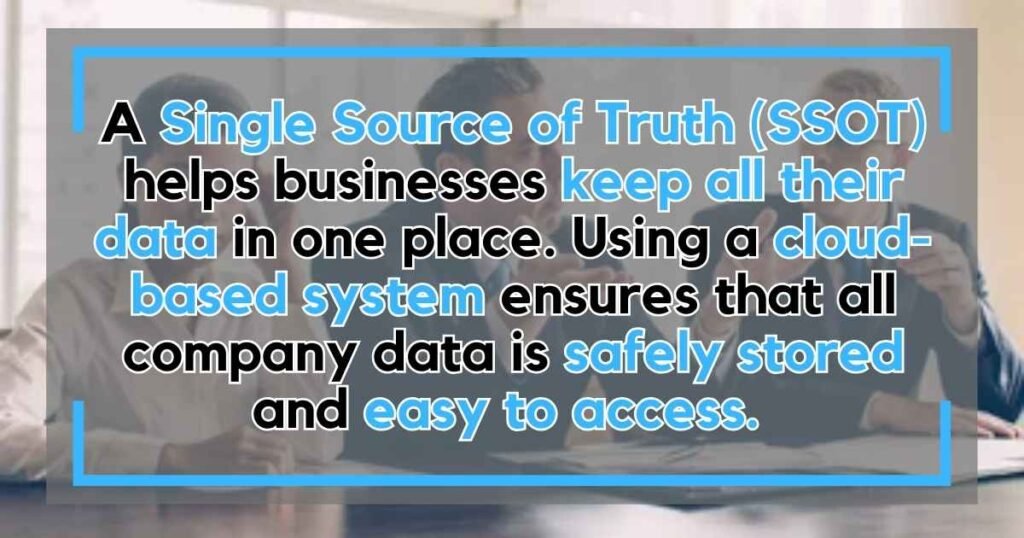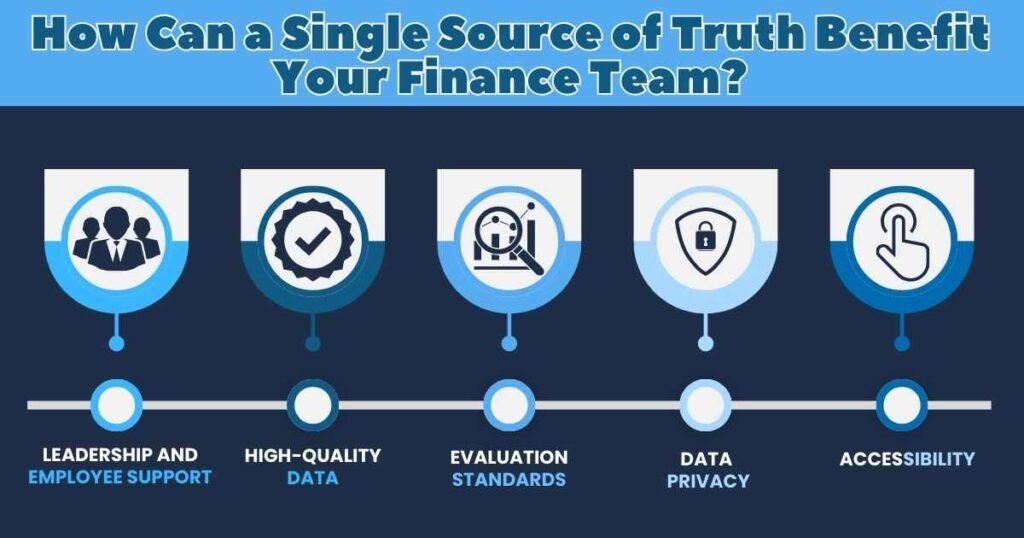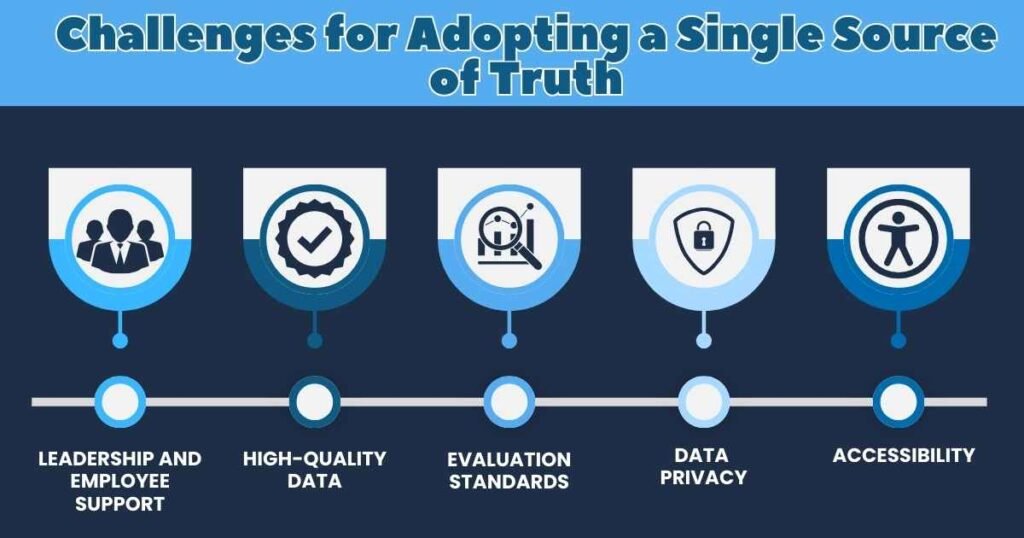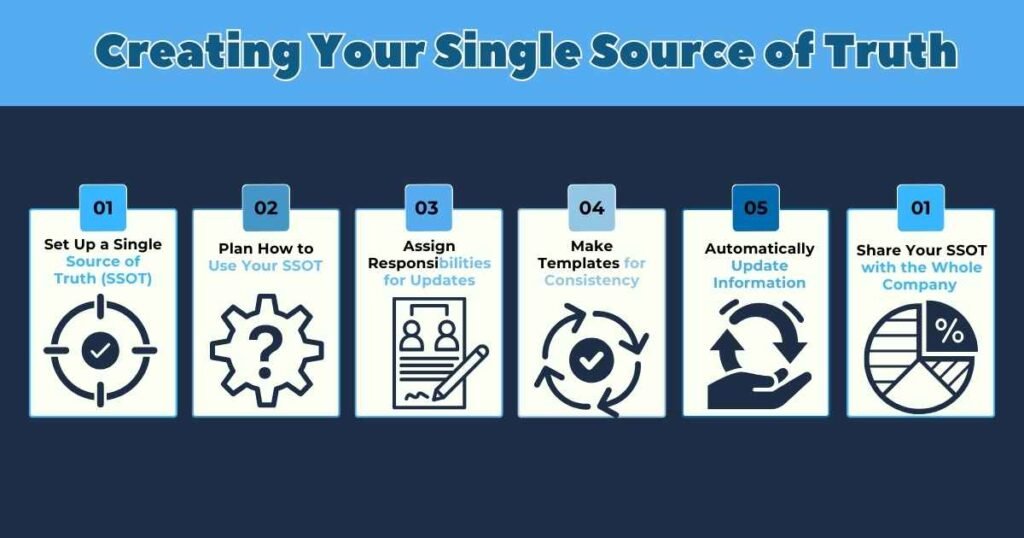In all-wheel-drive cars, a central computer monitors tire traction and adjusts power to keep the vehicle steady. This data also helps other systems, giving drivers the information they need to make smart choices. This same data flows into other systems, providing you with real-time information to make smart driving choices.
Similarly, in the business world, having a Single Source of Truth (SSOT) works like that car’s central computer. It gathers all your data in one place, ensuring everyone has accurate and up-to-date information.
What is a Single Source of Truth?

A Single Source of Truth (SSOT) helps businesses keep all their data in one place. Using a cloud-based system ensures that all company data is safely stored and easy to access. This makes work easier for finance professionals by cutting down on the time spent searching for documents, which saves both time and money.
Finance teams often depend on their data and important information, such as client details, billing, financial systems, and document management. However, they often encounter a problem where this data is scattered across different parts of the organization, making it hard to find what they need.
In a well-organized kitchen, all ingredients are labeled and stored in designated spots, so you can effortlessly find what you need without wasting time.
Likewise, an SSOT keeps all company data in one central location, ensuring everyone can swiftly access accurate and current information. This speeds up decision-making and boosts efficiency.
How Can a Single Source of Truth Benefit Your Finance Team?

Here are the four advantages of having a single source of truth for your finance team.
1. Easy Access to Correct Data
It’s frustrating when you can’t find the information you need, especially if you have a deadline. Wasting time on maintenance and administrative tasks that don’t make money can hurt your profits. Finding the right data quickly is important for keeping your team productive and profitable.
Cloud-based financial planning software helps because it gives you the information you need without wasting time on a long process. This way, you save time and can focus on other tasks instead of searching through piles of paperwork.
2. Faster Data Accuracy Checks
Entity management software allows you to easily edit and correct information when it’s wrong. In an accounting firm, accuracy is important. Paper documents can have multiple drafts, making it hard to find the latest and most accurate one.
With a cloud-based solution, you can quickly access the newest version, saving time and reducing errors. These systems also offer automated version control and real-time collaboration, enhancing accountability and efficiency.
3. Increased Productivity
Using a Single Source of Truth (SSOT) saves time by reducing the need for maintenance and administrative tasks, allowing you to focus more on meeting and assisting clients. This is especially beneficial for finance firms striving to stand out in a competitive industry by emphasizing transparency and standardization.
By automating manual processes and paperwork, you can improve your return on investment and have more time to attract new clients. Additionally, having a cloud-based SSOT enables finance teams to access it from anywhere, which is useful if your company transitions to a hybrid or remote-first workplace. This can also boost employee morale and productivity.
4. Break Down Data Silos
Using SSOT principles helps organizations make strategic changes without missing important connections or trends because data from different teams can inform decisions across the whole company. By breaking down data silos, an SSOT ensures that information flows freely between departments, reducing duplicated efforts and promoting teamwork.
This approach gives a complete view of the company’s performance and market trends, leading to better decisions. It also increases transparency and accountability, as everyone has access to the same accurate and up-to-date information. Overall, an SSOT creates a more unified and flexible organization, able to respond quickly to changes and opportunities.
5. Data Security and Transparency
It’s important to store and protect data correctly, especially because companies have higher expectations for clients’ data confidentiality. Using a cloud-based system as your SSOT for record-keeping and data management ensures security. Protecting your clients’ data and respecting their privacy is essential for your company’s reputation and trustworthiness. Mishandling data or leaks can harm your company’s reputation and hurt your business.
Being open and honest at work is very important. When people are transparent and accountable, it makes employees feel good and helps the company make more money. To be accountable, we need to talk openly, be truthful, and give feedback. Using cloud-based systems makes information easy to find, which makes the team more reliable and responsible. You can look at, change, and download the information easily, so it’s not hidden.
Making more money and being efficient are both important. With cloud-based software, you can be sure it works well and is easy to use. Everyone can work together on documents, and anyone can get the information because it’s in the cloud.
Challenges for Adopting a Single Source of Truth

Adopting the SSOT (Single Source of Truth) philosophy has many benefits, but a big change like this comes with challenges that need to be managed for successful adoption.
- Leadership and Employee Support
Leadership support is important for a major project like moving to SSOT. Clear communication with the entire team about the migration schedule is also important to avoid confusion and maintain productivity.
- High-Quality Data
Implementing data quality rules is essential for maximizing the long-term value of collected enterprise data. By ensuring data follows agreed-upon standards, organizations can reduce confusion, speed up analysis, and boost employee confidence in their conclusions.
- Evaluation Standards
To ensure consistency and transparency, establish standards for evaluating data in your universal datastore. This prevents different conclusions from being drawn from the same dataset while still allowing room for innovation.
- Data Privacy
To ensure data privacy, implement role-based access rules to limit sensitive information to those who need it. For instance, an HR professional may have access to employees’ Social Security numbers, while a business executive should not. Role-based permissions also help with compliance with data privacy regulations.
- Accessibility
To make data more accessible, provide self-service tools for building dashboards and visualizations, allowing all employees to feel ownership and engagement in achieving team and organizational goals.
Creating Your Single Source of Truth

It’s a single source of truth that provides you and your team with the necessary information to excel in your work.
Follow these steps to create SSOT for your team:
- Set Up a Single Source of Truth (SSOT)
Create a central hub for your team to organize and collaborate on projects and ideas. You can create pages for things like meeting agendas, project plans, and decision trees.
Features like commenting, tagging, and integrations with various apps make teamwork even smoother. To avoid confusion, discuss this change with your team and set aside time for them to move all their information to this one place.
- Plan How to Use Your SSOT
Decide on the basics, like what areas to create and which documents to track. Identify important parts of your work that need organized information, such as projects and client details. Use simple diagrams to see your workflows and find ways to make tasks easier.
Set clear rules for updating the SSOT to keep it consistent, and regularly check these processes to improve them. Make sure you have guidelines for entering, updating, and accessing data to keep the SSOT reliable.
- Assign Responsibilities for Updates
Maintain order in your SSOT by indicating who’s responsible for updating or archiving each document. For larger teams or organizations, you can appoint an overall “housekeeper” who ensures that all pages stay up to date.
This person will oversee the entire SSOT, making sure all pages stay up to date and that there are no outdated or incorrect documents.
- Make Templates for Consistency
Creating templates simplifies work by providing pre-made formats for tasks like meeting notes, project plans, reports, and emails. These templates ensure a consistent structure and style, making documents easier to understand and use.
Identify common document types and create templates for them. Store these in an easily accessible shared location. With a few clicks, you’ll have the right template, saving time and reducing errors. Regularly update templates to reflect changes in processes or branding, ensuring professionalism and efficiency.
- Automatically Update Information
Use macros to boost your team’s skills and keep your SSOT up-to-date. Macros automate repetitive tasks, saving time and reducing mistakes.
They help update data, create reports, and sync information automatically, ensuring your data is current and accurate. Furthermore, this improves decision-making and productivity. Plus, macros can be customized to fit your needs, making processes more efficient.
- Share Your SSOT with the Whole Company
If you’re the first to create an SSOT in your company, others can copy your method and adjust it to fit their needs. Write down your steps, offer training, and ask for feedback.
By sharing your way of doing things, everyone in the company can benefit from better communication, smarter decisions, and more efficiency.
Final Thoughts
An SSOT is a key tool for businesses, especially finance teams, because it stores all data in one safe place that everyone can access. Moreover, it makes work easier and saves time and money. Decision-makers always have the right information handy. Additionally, it also boosts data security and openness, which helps maintain trust and a good reputation. SSOT helps teams do their best and adapt to changing work conditions.
FAQs
What are the benefits of a single source of truth data?
The benefits of a Single Source of Truth (SSOT) include better data accuracy, higher productivity, improved data security, and smarter decision-making. Moreover, with all information in one place, teams can easily access up-to-date data, reducing errors and saving time on admin tasks. This also protects sensitive info and promotes transparency and accountability in the organization.
What is the value of a single source of truth?
The value of a Single Source of Truth is that it gives everyone in the company the same accurate and easy-to-access information. Furthermore, this consistency helps everyone work together better, improves efficiency, and supports smart decision-making. It also keeps data accurate and reduces mistakes and misunderstandings.
What is the goal of single source of truth?
The goal of a Single Source of Truth, or true source, is to put all data in one place so everyone in the company has the same, up-to-date information. However, this helps get rid of data silos, reduces repeated work, and boosts efficiency and productivity. In the end, it helps the organization make better decisions.
Why is single version of truth important?
One source of truth is important because it ensures all decisions are based on reliable and consistent information. It removes confusion and errors from having different data sources. Additionally, by providing one accurate set of data, it helps make better decisions, improves efficiency, and builds trust in the organization. This consistency is key for keeping data accurate and supporting strategic planning.
